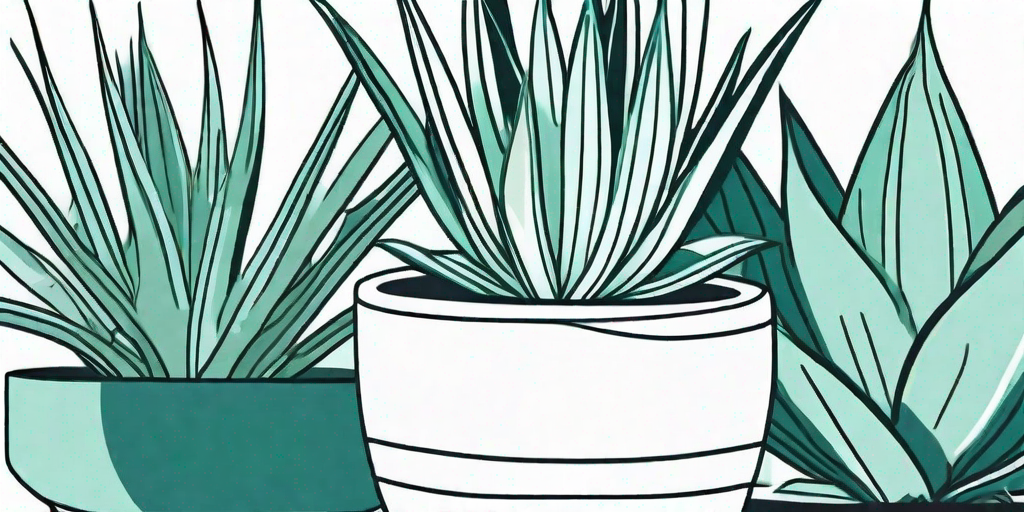
If you're looking for a way to add a touch of green to your living space without having to worry about constant upkeep, then the Agave houseplant is your new best friend. This cheeky little plant is as low-maintenance as they come, and it's got a personality to match. So, let's dive into the world of Agave and see what makes this plant such a great addition to your home.
Understanding the Agave Houseplant
Before we get into the nitty-gritty of caring for your Agave, let's take a moment to appreciate its unique charm. Native to the arid regions of the Americas, Agave plants are known for their striking rosette shape and spiky leaves. But don't let those spikes fool you - this plant is as friendly as they come.
There are many different species of Agave, each with their own unique characteristics. Some are small and compact, perfect for a windowsill or desk, while others can grow quite large, making a bold statement in any room. But regardless of their size, all Agave plants share a love for sunshine and a disdain for overwatering.
The History of Agave
Agave has a rich history that dates back thousands of years. These plants were highly valued by ancient civilizations for their many uses. The leaves were used to make fibers for ropes and textiles, the sap was used as a sweetener, and the heart of the plant was even used to make a potent alcoholic beverage known as pulque.
Today, Agave is still used in many of the same ways, but it's also gained popularity as a houseplant. Its unique shape and easy-care nature make it a favorite among plant enthusiasts and beginners alike.
How to Care for Your Agave Houseplant
Now that we've covered the basics, let's get down to the fun part - caring for your Agave. Despite its tough exterior, this plant is surprisingly easy to care for. All it needs is a sunny spot, well-draining soil, and a light watering every now and then.
But let's break it down a bit further, shall we?
Lighting and Temperature
Agave loves the sun. In fact, it thrives in bright, direct sunlight. So, the best spot for your Agave is near a south or west-facing window where it can soak up plenty of rays. If you don't have a sunny spot, don't worry - Agave can also tolerate lower light conditions, it just might not grow as quickly.
As for temperature, Agave is pretty flexible. It can tolerate a range of temperatures, from the high 70s during the day to the low 50s at night. Just make sure to keep it away from drafts and sudden temperature changes, which can cause stress to the plant.
Watering and Feeding
When it comes to watering, less is more with Agave. This plant is a succulent, which means it stores water in its leaves. Overwatering can lead to root rot, which is a surefire way to kill your plant. So, only water your Agave when the top inch of soil is dry to the touch.
As for feeding, Agave doesn't require much. A slow-release fertilizer applied once in the spring and once in the summer is all it needs to stay happy and healthy.
Common Problems and Solutions
Like any plant, Agave can encounter a few problems. But don't worry, we've got solutions for those too.
Yellowing Leaves
If the leaves of your Agave are turning yellow, it's likely a sign of overwatering. Remember, Agave is a desert plant and doesn't like to have wet feet. Cut back on watering and make sure your plant is in well-draining soil.
Brown Tips
Brown tips on your Agave are usually a sign of under watering or low humidity. Increase watering slightly and consider placing your plant on a tray of pebbles filled with water to increase humidity.
FAQs
- Is Agave toxic to pets?
Yes, Agave can be toxic to pets if ingested. The sap can cause irritation and the sharp spikes can cause injury. It's best to keep this plant out of reach of curious pets.
- Can Agave grow outdoors?
Yes, Agave can grow outdoors in zones 9-11. However, it's also a great indoor plant for those living in cooler climates.
- How often does Agave bloom?
Most Agave plants bloom only once in their lifetime, usually after 10-30 years. The bloom is a spectacular event, with a tall stalk growing from the center of the plant and producing numerous flowers.
Conclusion
So there you have it, everything you need to know about the low-maintenance Agave houseplant. With its striking appearance and easy-care nature, it's no wonder this plant is a favorite among green thumbs and beginners alike. So why not add a little green to your space with an Agave? You won't regret it!















